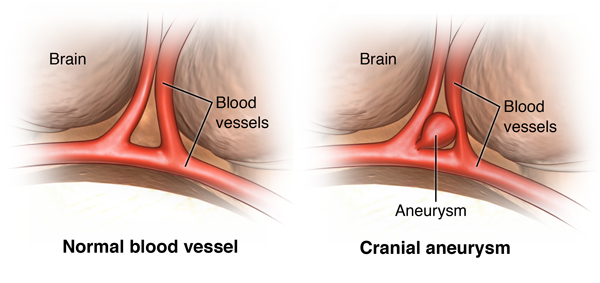What is a Brain Aneurysm?
A brain aneurysm, also referred to as a cerebral aneurysm, is a bulge in a weak area of the wall of a brain artery. It puffs out like a small balloon. It is also called an intracranial aneurysm. The bulge is also known as a bleb and makes the artery more likely to tear (rupture) in that spot.
A cerebral aneurysm more often happens in an artery under the front part of the brain, but aneurysms can form in arteries anywhere in the brain.
Types of aneurysms include:
- Berry (saccular) aneurysm. This is the most common type of cerebral aneurysm. It looks like a berry with a narrow stem. More than one of these may occur at the same time.
- Fusiform aneurysm. This type bulges out on all sides. This forms a dilated artery. This type is often linked to atherosclerosis.
- Dissecting aneurysm. This type is caused by a tear along the length of the artery in the inner layer of the artery wall. Blood leaks in between the layers of the wall. This may cause one side of the artery wall to balloon out. Or it may block blood flow through the artery. This type of aneurysm usually happens from a traumatic injury. But it can also form on its own. When these aneurysms are small and blister-like, they can result in very high rupture risks.
- Mycotic aneurysm. If bacteria spread in the blood, they can infect the artery wall. This weakens the wall and can turn into an aneurysm. More than one of these often occur at the same time. They are uncommon and are at higher risk of bleeding than other types.

Most brain aneurysms don't cause symptoms. Most are small. They are less than 5 mm across. Smaller aneurysms may be less likely to break, but not always.
What Causes a Brain Aneurysm?
The main cause of a brain aneurysm is a weakening in the wall of an artery. The pressure of the blood being pumped through the artery can then cause the bulge in that weak area. In certain areas, an aneurysm may have more pressure on it. For example, a place where the artery divides into smaller branches may have more pressure.
Researchers don't fully know what causes cerebral aneurysms. They are linked to several things, including:
- Advanced age
- Smoking
- High blood pressure
- Binge alcohol drinking
- Gender (more common among women)
- Family history of aneurysms
- Polycystic kidney disease